Effect of Stray Current on Corrosion and Calcium Ion Corrosion of Concrete Reinforcement
Abstract
:1. Introduction
2. Experimental
2.1. Experiment Material
2.2. Experiment Design
2.3. Test Method
3. Test Results and Analysis
3.1. Analysis of Influence Factors of Reinforcement Corrosion and Concrete Corrosion
- With the same diameter of reinforcement and the same energizing voltage, the smaller the strength grade of concrete, the more serious the corrosion of reinforcement and the smaller the critical corrosion rate at the time of concrete cracking. For example, after 100 h of power on, the corrosion rate of reinforcement in C25 concrete is 2.32%, and the rate in C35 concrete is 1.98%. Compared with the latter, the corrosion rate of reinforcement in the former increases by 17.17%. This is because the corrosion rate of reinforcement is affected by the water–cement ratio of concrete. The water–cement ratio of C25 concrete is 0.52, and the water–cement ratio of C35 concrete is 0.66. The smaller the water–cement ratio, the denser the concrete paste and the greater the concrete resistance, making the current through the reinforcement in the concrete smaller;
- With the same strength grade and energizing voltage, in the same energizing time, the larger the diameter of the reinforcement in the concrete specimen, the lower the corrosion rate and the later the crack occurs. It can be seen from Figure 4b that when the energizing voltage is 40 V, the corresponding earliest crack time of C35 concrete with reinforcement diameters of 12 mm, 14 mm and 16 mm is 50.2 h, 52.5 h and 53.2 h, respectively. The larger the diameter of the reinforcement, the smaller the corrosion rate when cracking, indicating that under the same corrosion rate, the larger the diameter of the reinforcement, the greater the rust expansion force caused by corrosion;
- With the same strength grade and reinforcement diameter, under the same energizing time, the greater the energizing voltage, the more serious the corrosion of reinforcement in the test piece. For example, the final corrosion rate of reinforcement under 40 V corrosion is 2.18 times that of 20 V. It can be seen from Figure 4c that the critical corrosion rate of reinforcement when concrete cracks under high voltage is small, because the higher the voltage, the fluffier the corrosion products [14], and the greater the compressive stress on the surrounding concrete, resulting in a reduction in the critical corrosion rate of cracking.
- The corrosion degree of low-grade concrete specimens is more serious than that of high-grade concrete specimens. For example, when the reinforcement diameter is 12 mm, the energizing voltage is 40 V and the energizing time is 100 h, the calcium ion content of C25 test piece is 0.561%, the calcium ion content of C30 test piece is 0.464%, and the calcium ion content of C35 test piece is 0.384%. This is because the water–cement ratio of the concrete with small strength grade is large, the porosity in the cement stone matrix is large, and the calcium ion in the concrete is easier to penetrate into the pore solution;
- At the same strength level and energizing voltage, the different diameters have no obvious effect on the corrosion results. For example, the calcium ion dissolution rates corresponding to the diameters of the three kinds of reinforcement after 100 h of power on are 0.384, 0.387%, and 0.385%, respectively, and the difference from the average is within 0.1%;
- When the voltage applied to the test piece is different, the dissolution rate of calcium ions is different. In the selected voltage range, the higher the voltage, the higher the dissolution rate of calcium ions. For example, when the voltage is 20 V, the dissolution rate of calcium ions is 0.27%, while the value is 0.374% when the voltage is 30 V, and the corresponding dissolution rate is 0.464% when the voltage is 40 V.
3.2. Analysis of the Interaction between Corrosion of Reinforcement and Calcium Ion Corrosion
3.2.1. Influence of Reinforcement Corrosion on Calcium Ion Dissolution
3.2.2. Influence of Calcium Ion Dissolution on Reinforcement Corrosion
3.3. Damage Analysis of Concrete Compressive Strength under Stray Current Corrosion
4. Conclusions
- The higher the strength grade, the lower the corrosion of the internal reinforcement and its electrochemical corrosion. With the increase in reinforcement diameter, the corrosion rate decreases, but the calcium ion dissolution rate is not affected by reinforcement diameter. The greater the stray current intensity, the greater the corrosion rate of reinforcement and the dissolution rate of calcium ions and the smaller the critical corrosion rate of reinforcement when concrete cracks under strong currents;
- The corrosion behavior of calcium ions in concrete under the stray current will slow down with the increase in the corrosion degree of reinforcement;
- Through nonlinear regression fitting of the test data, the regression equations of the original compressive strength, reinforcement diameter, corrosion voltage, electrification time and other parameters on the corrosion rate and calcium ion dissolution rate of reinforcement were obtained;
- The damage degree of concrete is closely related to the corrosion of reinforcement and the dissolution of calcium ions. The damage effect of rebar corrosion and calcium ion dissolution on concrete strength is affected by stray current intensity and rebar diameter. When the rebar corrosion rate and calcium ion dissolution rate are the same, the smaller the rebar diameter or the larger the stray current intensity, the more significant the damage effect is. Moreover, the damage effect of rebar corrosion on concrete compressive strength is more obvious than that of calcium ion dissolution.
Author Contributions
Funding
Institutional Review Board Statement
Informed Consent Statement
Data Availability Statement
Conflicts of Interest
References
- Xu, W.; Zhang, B.; Deng, Y.; Wang, Z.; Jiang, Q.; Yang, Q.; Yang, L.; Zhang, J. Corrosion of rail tracks and their protection. Corros. Rev. 2021, 39, 1–13. [Google Scholar] [CrossRef]
- Zhang, B.; Zhao, J.; Zeng, R.; He, J. Numerical analysis of DC current distribution in AC power system near HVDC system. IEEE Power Deliver. 2008, 23, 960–965. [Google Scholar] [CrossRef]
- Bertolini, L.; Carsana, M.; Pedeferri, P. Corrosion behaviour of steel in concrete in the presence of stray current. Corros. Sci. 2007, 49, 1056–1068. [Google Scholar] [CrossRef]
- Liu, F.; Zou, Y.; Wang, B.; Yuan, X. The Effect of Stray Current on Calcium Leaching of Cement-Based Materials. Materials. 2022, 15, 2279. [Google Scholar] [CrossRef] [PubMed]
- Xu, W.; Li, Y.; Li, H.; Wang, K.; Zhang, C.; Jiang, Y.; Qiang, S. Corrosion mechanism and damage characteristic of steel fiber concrete under the effect of stray current and salt solution. Constr. Build. Mater. 2022, 314, 125618. [Google Scholar] [CrossRef]
- Yang, S.; Yang, X. Evaluation of stray current corrosion resistance of concrete in metro construction. FSCE 2008, 2, 246–252. [Google Scholar] [CrossRef]
- Chen, Z.; Koleva, D.; Breugel, K.V. A review on stray current-induced steel corrosion in infrastructure. Corros. Rev. 2017, 35, 397–423. [Google Scholar] [CrossRef]
- Ekstrom, T. Leaching of concrete: The leaching process and its effects. Ph.D. Thesis, Lund University, Hörsalen, Lund, Sweden, 2003. [Google Scholar]
- Aghajani, A.; Urgen, M.; Bertolini, L. Effects of DC Stray Current on Concrete Permeability. J. Mater. Civil. Eng. 2016, 28, 04015177. [Google Scholar] [CrossRef]
- Dolara, A.; Foiadelli, F.; Leva, S. Stray current effects mitigation in subway tunnels. IEEE T. Power Deliver 2012, 27, 2304–2311. [Google Scholar] [CrossRef]
- Bertolini, L. Steel corrosion and service life of reinforced concrete structures. Struct. Infrastruct. E. 2008, 4, 123–137. [Google Scholar] [CrossRef]
- Woo, R.; Zhu, H.; Chow, M.; Leung, C.; Kim, J. Barrier performance of silane–clay nanocomposite coatings on concrete structure. Compos. Sci. Technol. 2008, 68, 2828–2836. [Google Scholar] [CrossRef] [Green Version]
- Zhang, G.; Li, X.; Li, Z. Experimental study on static mechanical properties and moisture contents of concrete under water environment. Sustainability 2019, 11, 2962. [Google Scholar] [CrossRef] [Green Version]
- Saatchi, A.; Aghajani, A. Cathodic Protection Concerns in Large Installations. Mater. Perform. 2005, 1, 22–25. [Google Scholar]
- Wu, L.; Dai, P.; Li, Y. Determination of the Transport Properties of Structural Concrete Using AC Impedance Spectroscopy Techniques. J. Eng. 2016, 2016, 2630186. [Google Scholar] [CrossRef]
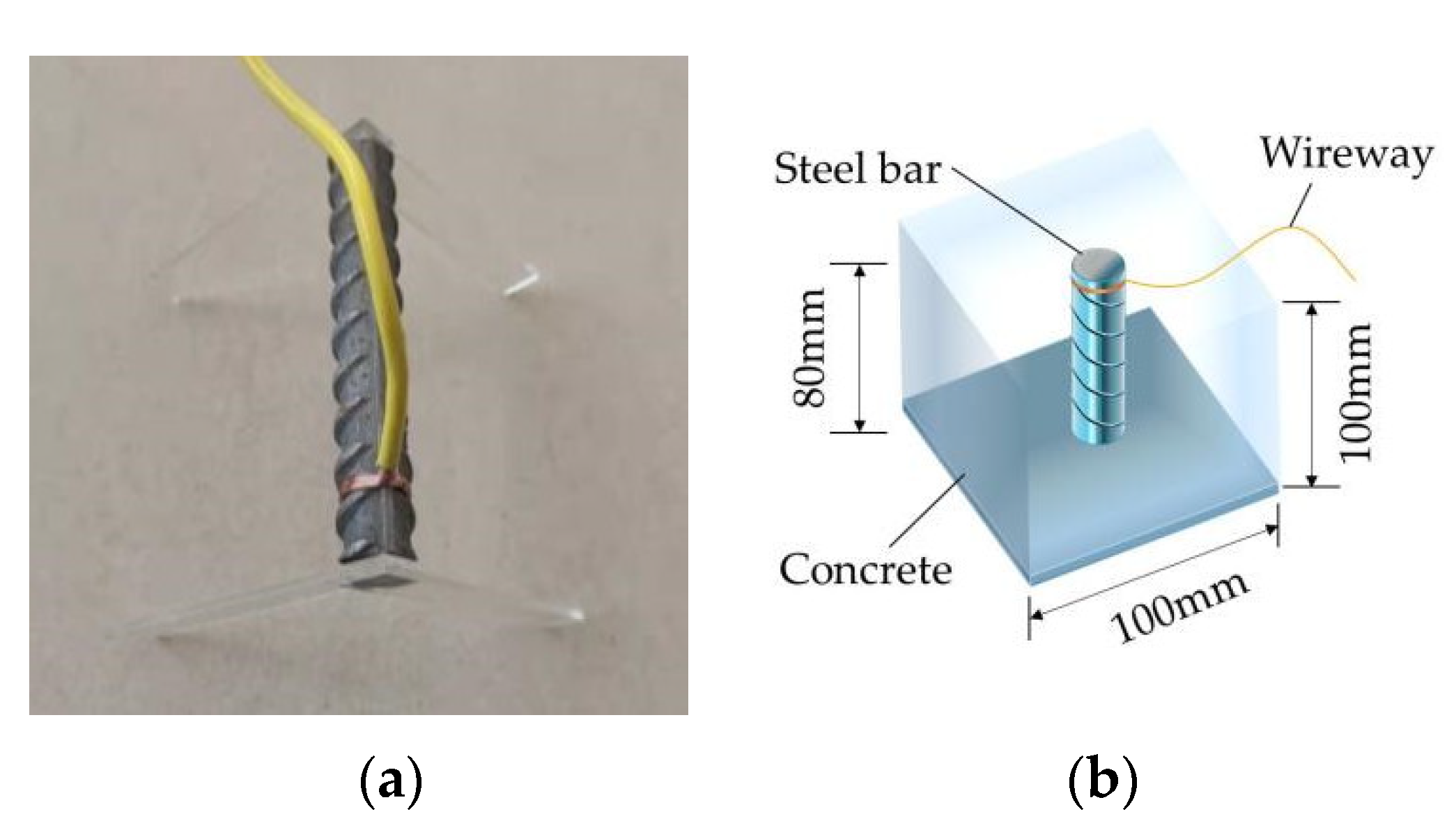
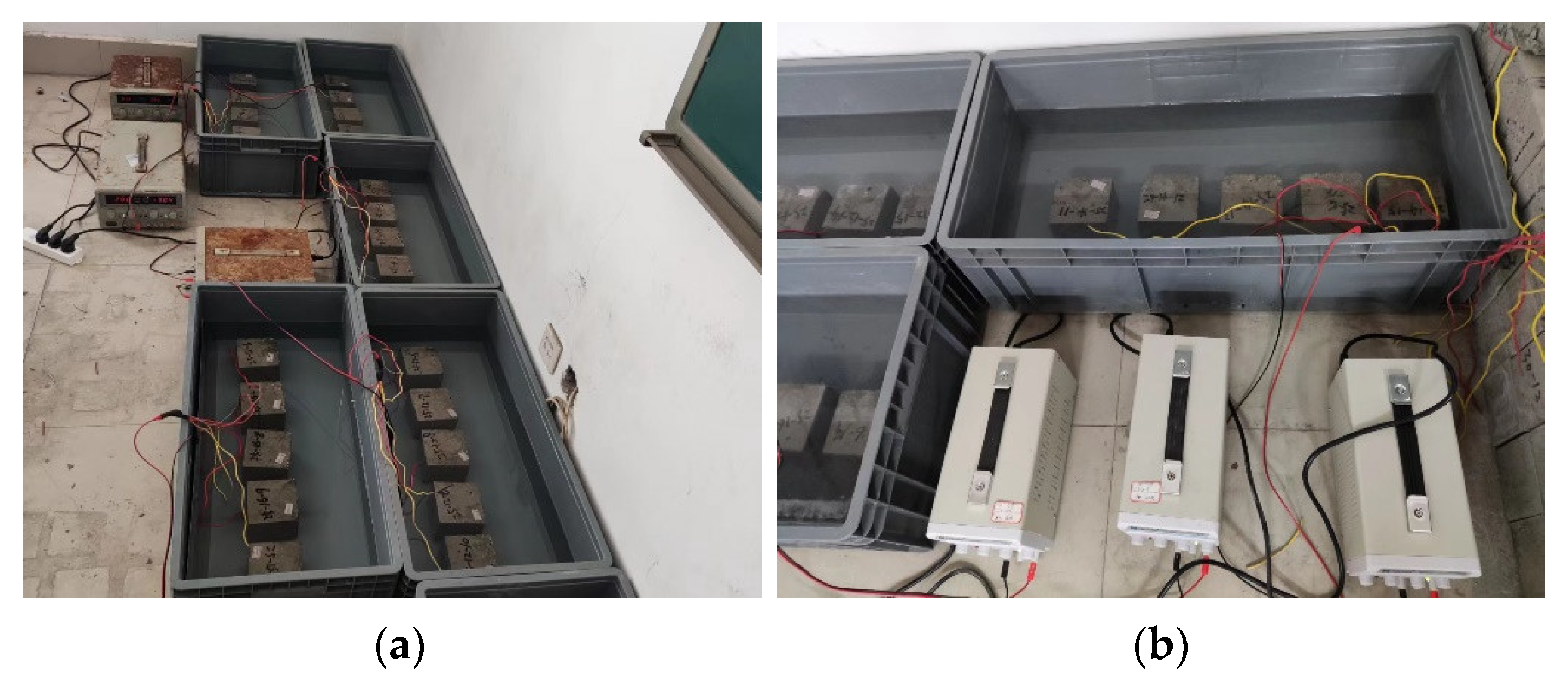




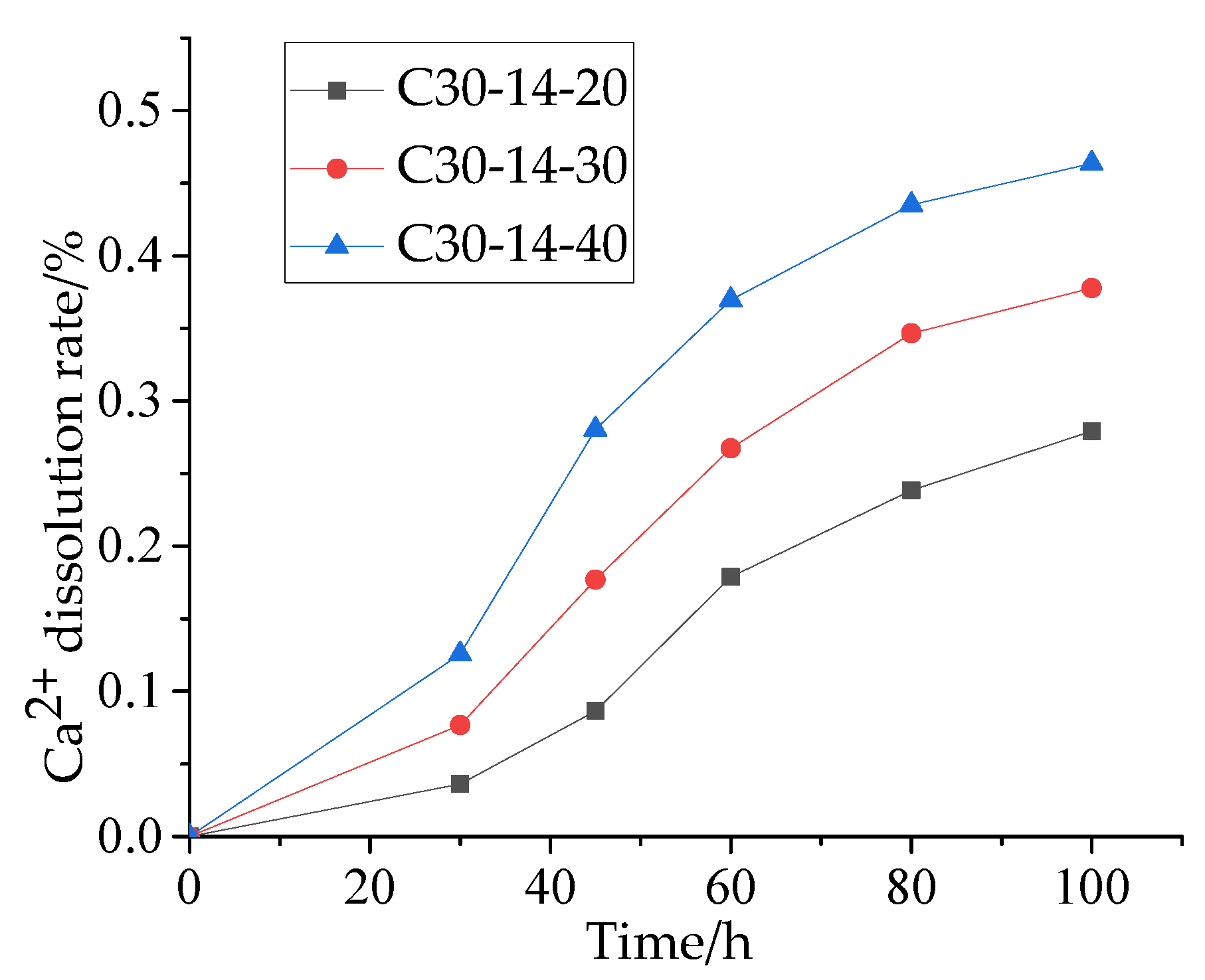
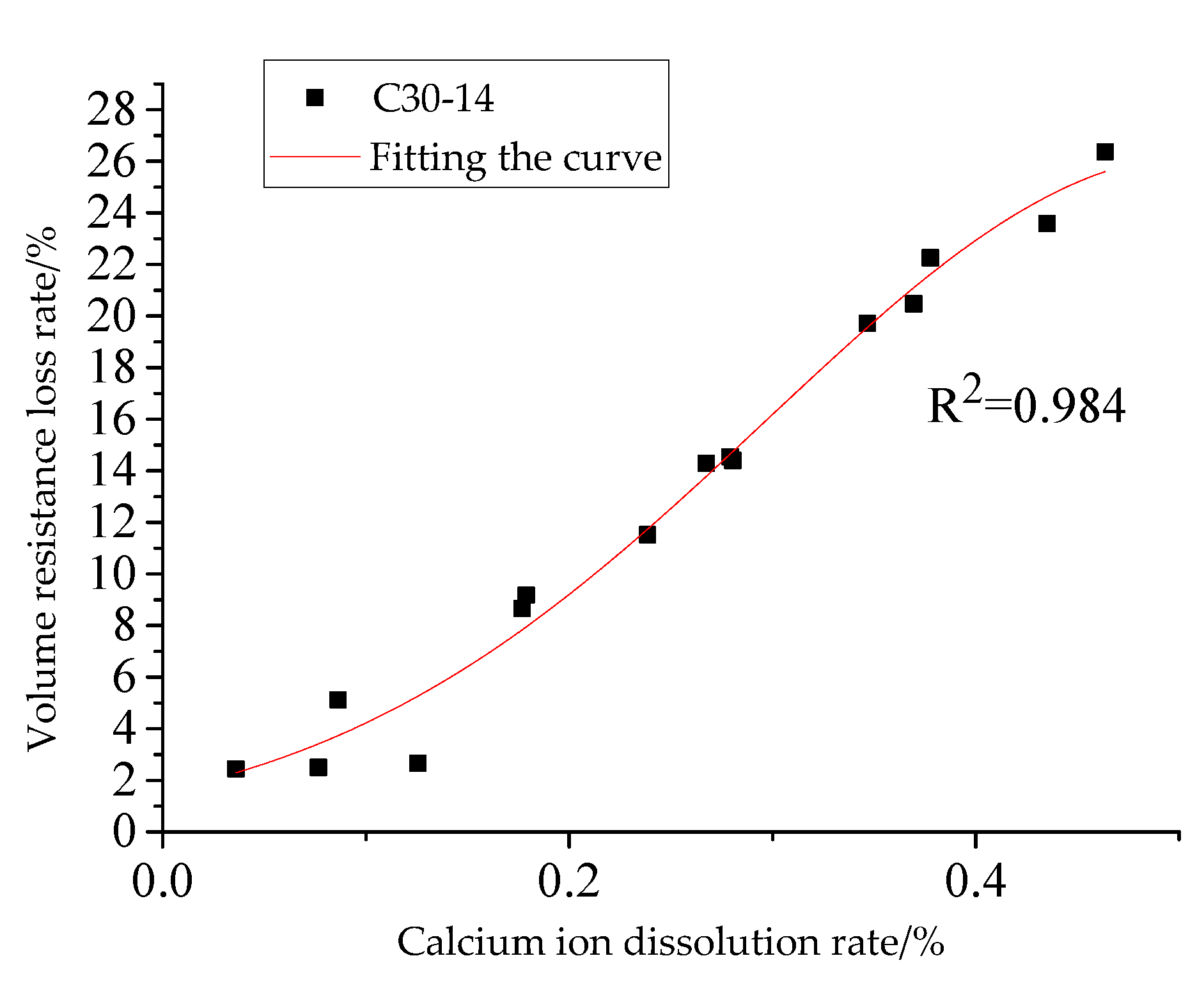
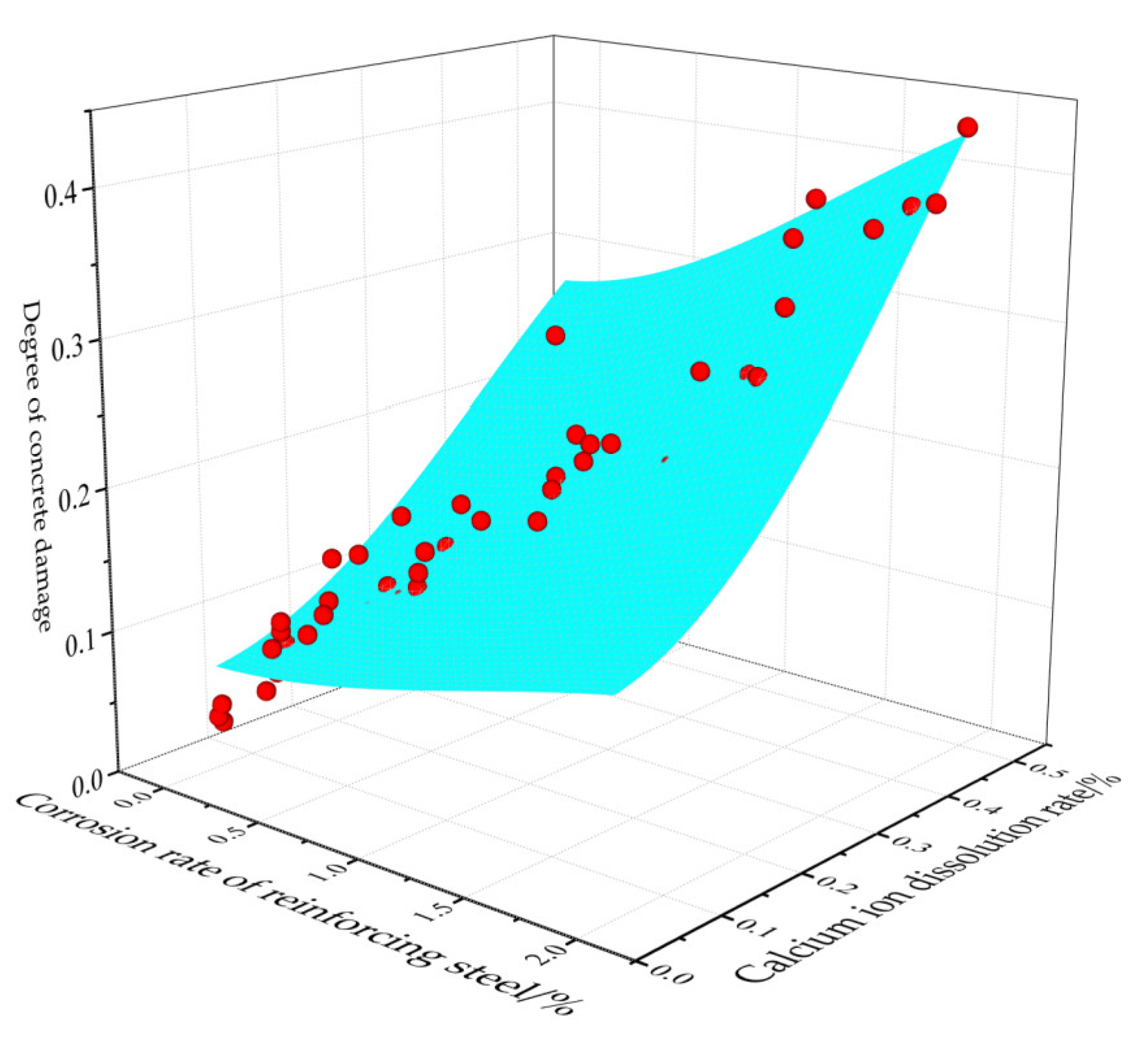
| Chemical Composition | CaO | SiO2 | Al2O3 | SO3 | FeO | MgO | K2O | LOI |
|---|---|---|---|---|---|---|---|---|
| P·O 42.5 | 62.1 | 21.3 | 5.7 | 3.6 | 2.3 | 2.0 | 0.3 | 2.9 |
| Group | Strength Grade | Reinforcement Diameter (mm) | Power on Voltage (V) | Water–Cement Ratio | Mix Proportion | ||||
|---|---|---|---|---|---|---|---|---|---|
| Sand Ratio (%) | Cement (kg/m3) | Sand (kg/m3) | Stone (kg/m3) | Water (kg/m3) | |||||
| C25-12-40 | C25 | 12 | 40 | 0.66 | 39 | 303 | 730 | 1167 | 200 |
| C30-12-20 | C30 | 12 | 20 | 0.58 | 36 | 345 | 659 | 1197 | 200 |
| C30-12-30 | C30 | 12 | 30 | 0.58 | 36 | 345 | 659 | 1197 | 200 |
| C30-12-40 | C30 | 12 | 40 | 0.58 | 36 | 345 | 659 | 1197 | 200 |
| C30-14-20 | C30 | 14 | 20 | 0.58 | 36 | 345 | 659 | 1197 | 200 |
| C30-14-30 | C30 | 14 | 30 | 0.58 | 36 | 345 | 659 | 1197 | 200 |
| C30-14-40 | C30 | 14 | 40 | 0.58 | 36 | 345 | 659 | 1197 | 200 |
| C30-16-20 | C30 | 16 | 20 | 0.58 | 36 | 345 | 659 | 1197 | 200 |
| C30-16-30 | C30 | 16 | 30 | 0.58 | 36 | 345 | 659 | 1197 | 200 |
| C30-16-40 | C30 | 16 | 40 | 0.58 | 36 | 345 | 659 | 1197 | 200 |
| C35-12-40 | C35 | 12 | 40 | 0.52 | 33 | 385 | 590 | 1225 | 200 |
| C35-14-40 | C35 | 14 | 40 | 0.52 | 33 | 385 | 590 | 1225 | 200 |
| Number | Power on Time (h) | ||||
|---|---|---|---|---|---|
| 30 | 45 | 60 | 80 | 100 | |
| C30-14-20 | 0.66 | 2.76 | 6.19 | 7.99 | 9.50 |
| C30-14-30 | 0.93 | 4.64 | 8.01 | 10.77 | 12.03 |
| C30-14-40 | 1.18 | 5.68 | 9.11 | 11.60 | 13.49 |
Publisher’s Note: MDPI stays neutral with regard to jurisdictional claims in published maps and institutional affiliations. |
© 2022 by the authors. Licensee MDPI, Basel, Switzerland. This article is an open access article distributed under the terms and conditions of the Creative Commons Attribution (CC BY) license (https://creativecommons.org/licenses/by/4.0/).
Share and Cite
Yang, W.; Ye, X.; Li, R.; Yang, J. Effect of Stray Current on Corrosion and Calcium Ion Corrosion of Concrete Reinforcement. Materials 2022, 15, 7287. https://doi.org/10.3390/ma15207287
Yang W, Ye X, Li R, Yang J. Effect of Stray Current on Corrosion and Calcium Ion Corrosion of Concrete Reinforcement. Materials. 2022; 15(20):7287. https://doi.org/10.3390/ma15207287
Chicago/Turabian StyleYang, Weijun, Xin Ye, Rongjun Li, and Jianyu Yang. 2022. "Effect of Stray Current on Corrosion and Calcium Ion Corrosion of Concrete Reinforcement" Materials 15, no. 20: 7287. https://doi.org/10.3390/ma15207287




